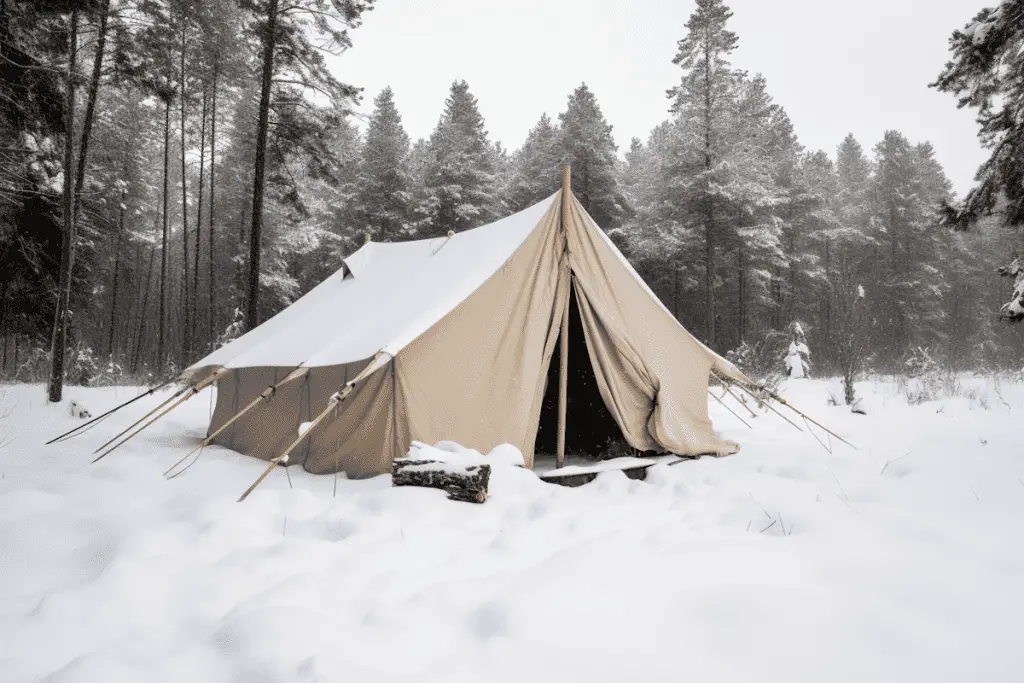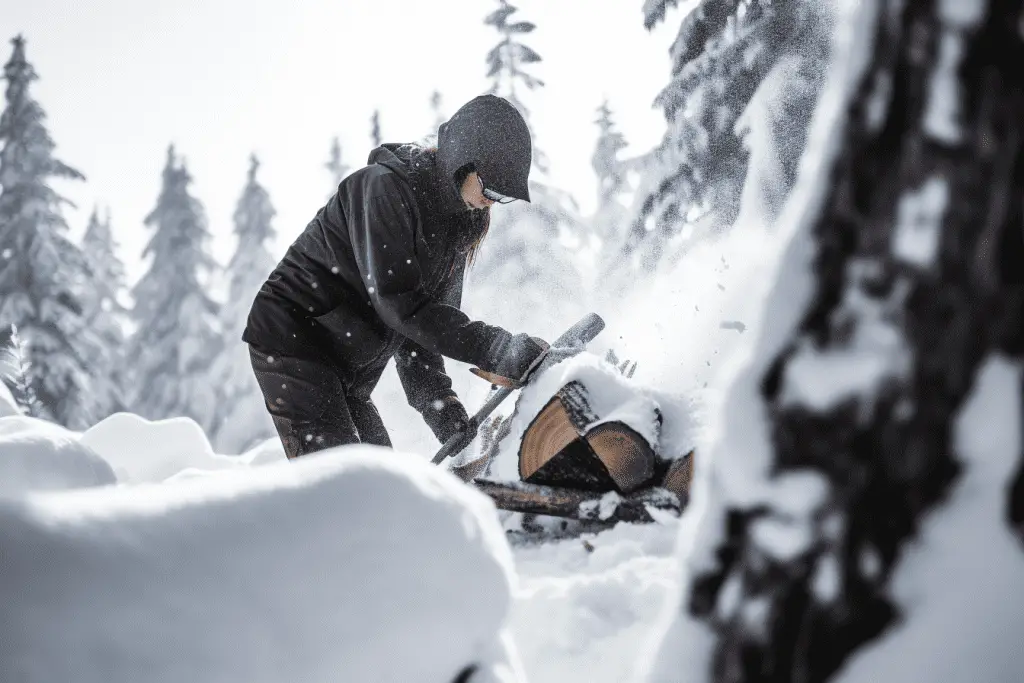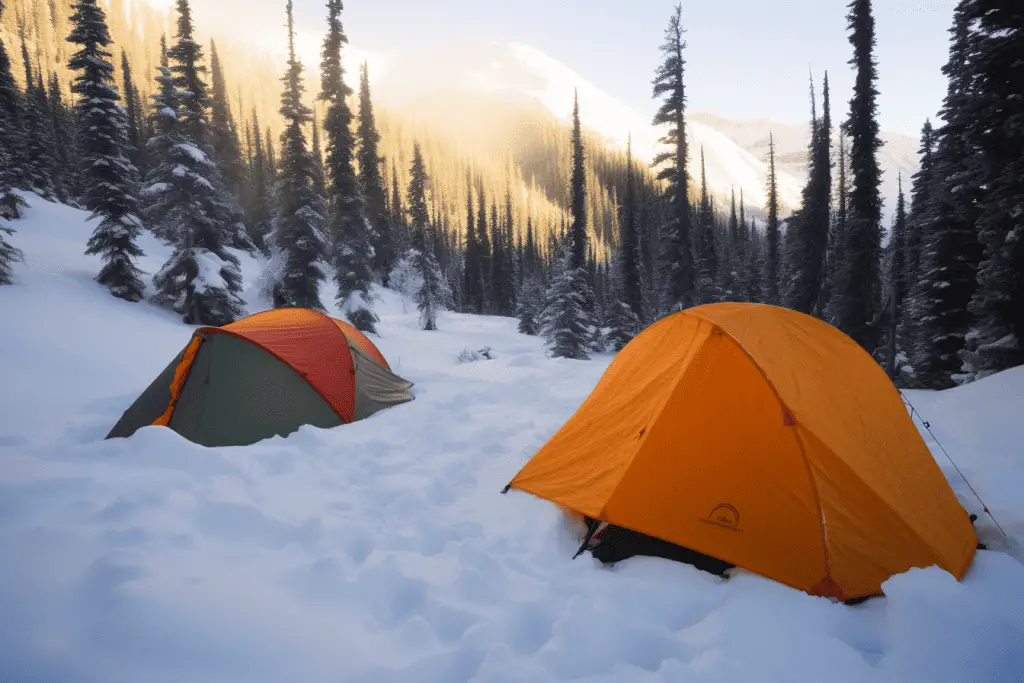Hot tenting is becoming more and more popular with each passing year. But, what is hot tenting?
Hot tenting is a type of winter camping where a tent is set up with a wood stove inside to keep the interior warm. This allows for comfortable camping in colder temperatures and opens up new opportunities for winter outdoor activities.
Picture this: You’re in the middle of a snow-covered forest, it’s freezing outside, but you’re inside a cozy, warm tent, completely protected from the elements. That’s hot tenting!

The secret to this unique form of camping is a specialized tent and a portable wood stove. The tent, usually made of durable, fire-resistant material, houses a small stove that you feed with wood to generate heat. Think of it as your personal, portable cabin in the woods. Hot tenting allows you to enjoy the beauty of winter camping without sacrificing comfort and warmth.
It’s not just about comfort, though. In extreme winter conditions, hot tenting can be crucial for survival. It provides a warm, dry environment, which can prevent hypothermia and other cold-related ailments. Hot tenting truly revolutionizes the winter camping experience, making it a great adventure rather than a chilly ordeal. Stick with us as we dive deeper into this intriguing outdoor activity.
Essential Equipment for Hot Tenting
The star of the show is, of course, the hot tent itself. These aren’t your everyday summer camping tents. They’re made from heavier, often fire-resistant materials, and they have a special vent for the chimney of your wood stove. Sizes and designs vary, so think about how many people you need to shelter and how much weight you’re willing to carry when choosing your tent.
Next, you’ll need a wood stove. This is your heat source, your comfort bringer, and your lifesaver in harsh winter conditions. It’s not just for warmth, either—you can also use it for cooking! Like the tent, you’ll find stoves in a variety of sizes and designs, so consider your needs when making your choice.
To keep your stove fed, you’ll need a good-quality saw or axe. You might think, “I’ll just find deadwood,” but trust me, when it’s cold and snowing, you’ll be glad you brought a tool to cut wood more efficiently. A stove pipe thermometer is also a good addition. It will help you manage the fire better and prevent overheating.

Then there’s your regular winter camping gear. Think sleeping bags rated for the lowest temperatures you expect, good quality sleeping pads, and warm clothing. Also, always remember to pack your first aid kit and survival essentials like a multi-tool, flashlight, and navigation aids.
So, that’s your basic hot tenting kit. Every item in there has an important role to play, from keeping you warm to making sure you’re safe. As you get more into hot tenting, you might find other pieces of gear that suit your specific needs or make your experience even better.
How to Choose a Tent for Hot Tenting
Choosing the right hot tent is key to your winter camping adventure. So let’s dive into some important factors to consider when making that selection.
First up, size matters. If you’re planning a solo adventure or a trip with just one companion, a smaller tent could be perfect. It’s not just about sleeping space though—think about gear storage, space for the stove, and whether you want room to stand up. If you’re camping with a group, you’ll obviously need a larger tent. Just remember, larger tents are heavier and can be more difficult to heat.
Next, consider the material of the tent. Most hot tents are made from heavy-duty, fire-resistant fabrics like canvas or synthetic variants. Canvas tents can be heavier but they breathe well, reducing condensation. Some synthetic materials might be lighter but make sure they can stand up to the heat.
The design of the tent is another big factor. Traditional designs are more rectangular with vertical walls, maximizing living space. Modern designs can be more compact and lightweight, often featuring a pyramid or dome shape. Also, look for designs with good ventilation to manage stove fumes and condensation.
Then there’s the stove jack, which is where the stovepipe exits the tent. It should be well-constructed and fire-resistant. Some tents come with a stove jack included, while others might require you to install one yourself.
Lastly, think about your typical camping conditions. If you’re dealing with heavy snow, look for a tent with steep walls to prevent snow accumulation. For windy conditions, go for a design that can be anchored securely.
In short, the best hot tent for you depends on your personal camping style, the number of people you camp with, and the conditions you’ll face. It might take a bit of research, but finding the perfect tent is definitely worth the effort. After all, this is going to be your cozy home in the wilderness!
Understanding Wood Stoves for Hot Tenting
A wood stove is the heart of your hot tent setup. It’s not just for keeping you warm and cozy; it can also be used for cooking meals and melting snow for water. Understanding the basics of these stoves can make your hot tenting adventure more enjoyable and safe.
Wood stoves for hot tenting come in different sizes and shapes, so the first thing to consider is what suits your needs. If you’re solo camping or traveling light, a compact, lightweight stove could be the best fit. For larger groups or longer trips, a bigger stove that can hold more wood and generate more heat might be necessary.
Material is another important factor. Many wood stoves are made from stainless steel or titanium. Stainless steel stoves are generally more durable and cheaper, but they’re heavier. Titanium stoves are lighter and resist corrosion better, but they tend to be pricier.
Remember that efficiency matters. You want a stove that burns wood effectively to provide enough heat and reduce the frequency of refilling. Some stoves come with a damper control, which helps you regulate the burn rate and maintain a consistent temperature.
Don’t forget to consider safety features, like a spark arrestor on the chimney to prevent embers from escaping. You might also want a stove with a reinforced top surface that can support the weight of pots and pans for cooking.
And finally, think about how easy it is to assemble, use, and pack up the stove. If you’re moving campsites frequently, a stove that’s quick to set up and take down can be a real advantage.
Once you’ve chosen the right wood stove, make sure you know how to use it safely. Remember, it’s all about enjoying the outdoors comfortably and responsibly!
Setting Up Your Hot Tent: Step-by-Step Guide
Step 1: Choose a Location – Firstly, choosing the right location is key. Look for a flat, clear area, ideally protected from strong winds. If it’s snowing, make sure to pack down the snow on your chosen spot to create a firm base.
Step 2: Pitch Your Tent – Once you’ve chosen your spot, it’s time to pitch your tent. This process can vary depending on your tent’s design, but generally, you’ll stake down the corners first, then insert and raise the poles. Make sure all sides are pulled taut and secure.
Step 3: Install Your Stove – With the tent pitched, next comes the stove installation. Position the stove towards the front of the tent for easy access, but ensure there’s enough clearance between it and the tent walls. Then, assemble the stovepipe. Make sure it’s straight and secure, and that it goes through the stove jack in the tent.
Step 4: Layout the Interior – Now, it’s time to make your inside arrangements. Place your sleeping gear on the opposite side of the stove to avoid any accidents. If you’re using a sleeping pad, make sure it’s heat-resistant or placed far enough from the stove. The same goes for your other gear – keep it well-organized and away from the stove.
Step 5: Ventilate – Lastly, plan for ventilation. Ensure any vents or windows are accessible and open slightly to allow fresh air in and stove fumes out. This is crucial for safety and managing condensation.
And that’s it! Setting up a hot tent can seem a bit daunting at first, but with some practice, you’ll be doing it like a pro in no time. Once you’ve got your setup right, you can look forward to many cozy nights in the great outdoors, no matter how cold it gets outside!
Tips for Safe Wood Stove Operation
First, keep flammable materials away from the stove. This includes your sleeping gear, clothing, and other camping equipment. Remember, the stove will get very hot, so maintain a safe distance.
When it comes to fuel, only use dry, well-seasoned wood. Green or wet wood can create a lot of smoke and isn’t as efficient. Don’t overload the stove; it’s better to refuel more frequently with smaller amounts of wood.
Regularly check the stovepipe for any build-up of soot or creosote, which can be a fire hazard. Some stoves have a damper control that you can adjust to regulate airflow and prevent overburning or excessive smoke.
Always ensure there’s adequate ventilation in your tent when the stove is operating. This will prevent the build-up of harmful fumes and also help manage condensation.
Before you go to sleep or leave the tent, make sure the fire is out or at least safely contained. Never leave a burning stove unattended.
Last but not least, always keep a fire extinguisher or a bucket of snow or sand handy, just in case.
Maintaining a Comfortable Temperature Inside Your Hot Tent
First and foremost, the wood stove is the heart of your heating system. Learning to manage it well is crucial. Start by feeding it with small amounts of wood until you get a feel for how it heats your tent. Over time, you’ll learn how much wood is needed to maintain your desired temperature.
Make use of the damper control if your stove has one. This adjusts the airflow in your stove, which can either increase the intensity of the burn for more heat, or slow it down to maintain a steady, warm temperature.
A stovepipe thermometer can be a real game changer. It allows you to monitor the temperature of your stove and adjust accordingly. It’s a handy tool to prevent overheating or underheating.
But temperature management isn’t just about the stove. The design of your tent plays a role too. Hot air rises, so taller tents will have a warmer top and cooler bottom. Using a small fan can help circulate the warm air and maintain a more consistent temperature.
Remember to adjust your ventilation as well. While it’s important to keep fresh air flowing in and stove fumes flowing out, too much open ventilation can let a lot of heat escape. Find a balance that works for your tent and the outside conditions.
Lastly, don’t forget about your own personal thermostat – your clothing! Layer up or down as needed to stay comfortable, and always have a warm sleeping bag to snuggle into.
Packing for a Hot Tenting Trip: What to Bring
First and foremost, you’ll need your hot tent and wood stove. Don’t forget essential accessories like the stovepipe, a tool for cutting firewood, and maybe a stovepipe thermometer for heat management.
Next is your sleeping gear. Choose a sleeping bag rated for the lowest temperature you might encounter and a good quality sleeping pad for insulation from the cold ground. A pillow can add an extra touch of comfort!
Your clothing is crucial. Think layers so you can adjust to changing conditions. This includes moisture-wicking base layers, insulating mid-layers, and waterproof and windproof outer layers. Don’t forget warm socks, gloves, and a hat, as well as spare clothing in case things get wet.
In terms of food, consider easy-to-cook meals and high-energy snacks. You might be able to use your wood stove for cooking, so pack appropriate pots and utensils. Don’t forget a reliable water container, and if you’ll be relying on snow for water, a good pot for melting snow.
Pack a first aid kit tailored for the wilderness. It should include items for wound care, medication for common ailments, and any personal medication you might need. A survival kit is also a must, with items like a multi-tool, fire starter, compass, and emergency blanket.
Remember the lighting equipment. Headlamps are great for hands-free operations, and a lantern can provide light for the entire tent.
Lastly, consider your entertainment. Bring a good book, a deck of cards, or download some movies on your device ahead of time. After all, you’ll be spending more time inside the tent when you’re hot tenting.
Hot Tenting vs. Traditional Winter Camping
Traditional winter camping typically involves using a four-season tent without any built-in heat source. You rely solely on warm clothing, a good sleeping bag, and perhaps a thermal pad for warmth. It’s a simpler setup that usually involves lighter gear, making it a favorite among backpackers and those who prefer to move camp regularly. However, the lack of a heat source means that you’re at the mercy of the elements, which can be quite challenging in colder climates.
On the other hand, hot tenting provides a warm and comfortable shelter in the heart of winter’s chill. The wood stove can keep the tent interior pleasantly warm, allowing you to escape the freezing temperatures outside. This not only boosts comfort but also increases safety in extreme conditions by reducing the risk of hypothermia and frostbite. Moreover, you can dry wet clothes, melt snow for water, and cook meals on the stove.

However, the gear for hot tenting tends to be heavier and bulkier, which can make it less suitable for trips where you’ll be changing campsites frequently. Setting up the tent and stove also requires a bit more time and effort compared to traditional camping. Additionally, you’ll need to source or carry wood for the stove, which adds another task to your camping routine.
In summary, the choice between hot tenting and traditional winter camping often comes down to personal preference, the nature of your trip, and the conditions you’ll be facing. Each style has its unique benefits and challenges. The beauty of winter camping, in whichever style you choose, is the chance to enjoy nature’s tranquility during the colder months.
Cleaning and Maintenance Tips for Hot Tents
Keeping your hot tent clean and well-maintained is key to ensuring it lasts for many adventures to come. Here are some tips to help you with that.
- Keep it Clean During Your Trip: Regularly sweep out dirt and debris to avoid damage to the tent floor. Clean up any spills promptly to avoid stains or smells.
- Clean After Each Trip: After your adventure, shake out the tent to remove loose dirt. Use mild soap and warm water to clean any dirty or stained areas, avoiding harsh detergents which can damage the tent’s water-resistant coating.
- Dry Before Storing: Always ensure your tent is completely dry before storing it. Packing away a damp tent can lead to mold and mildew. If you have to pack it away wet, make sure to unpack and dry it as soon as you can.
- Clean the Stove: Empty out the ash from the stove after every use to maintain its efficiency and reduce fire risks. Inspect and clean the stovepipe regularly to prevent creosote build-up.
- Regularly Inspect for Damage: Check your tent and stove for any signs of damage after each trip. Look for any rips or tears in the tent material, ensure all the zippers are working smoothly, and check the stove for signs of rust or any loose parts.
- Store Properly: Keep your tent and stove in a cool, dry place away from direct sunlight. Sunlight can fade the tent material and reduce its lifespan.
Remember, proper care and maintenance of your hot tent will extend its lifespan and make your camping experiences more enjoyable!
Embrace The Warmth With Hot Tenting
Hot tenting is truly a game-changer for those who crave the quiet solitude of the winter wilderness. It’s about embracing the beauty of the outdoors, even in the chilliest of seasons. By bringing the comfort of a warm, cozy shelter to your campsite, hot tenting allows you to venture further and stay out longer, even when the temperatures drop below freezing.
From selecting the right equipment and setting up your cozy abode, to maintaining a comfortable temperature and ensuring safe wood stove operation, there’s a lot to learn when you start hot tenting. But don’t let that daunt you. As with any outdoor pursuit, the more you do it, the better you get. And the rewards – the warmth, the comfort, the extended time in nature – are truly worth it.
Pack wisely, respect the environment, and practice safe camping habits. Remember that hot tenting, like all forms of camping, is about harmonizing with nature rather than trying to conquer it.
In conclusion, hot tenting is a fantastic way to deepen your connection with the great outdoors and make winter your favorite camping season. So go ahead, embrace the warmth of the wilderness, and let hot tenting open up a whole new world of winter adventures for you.
